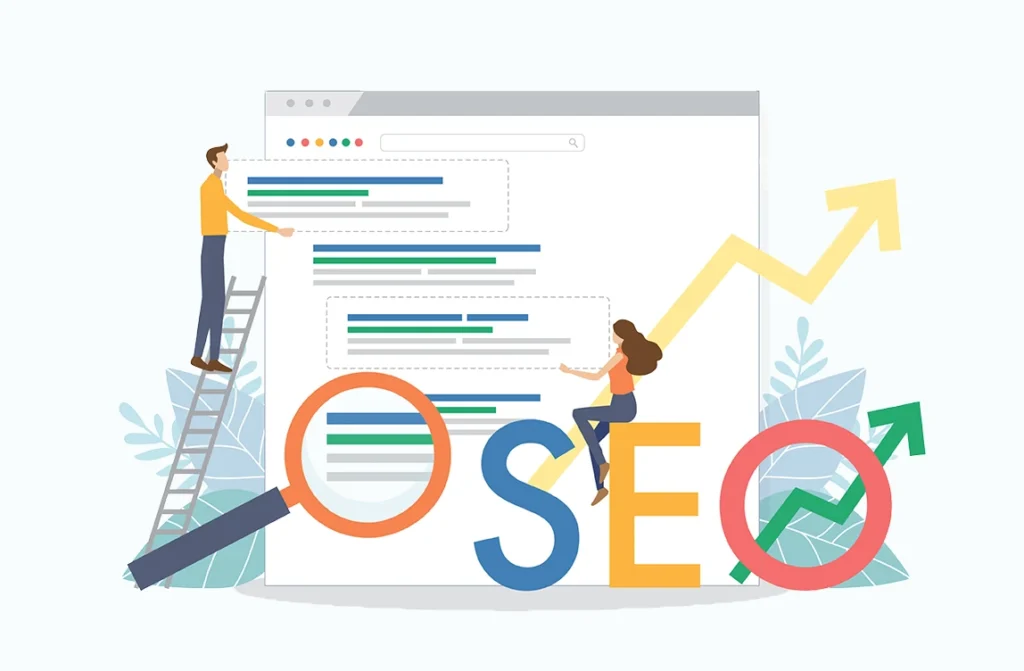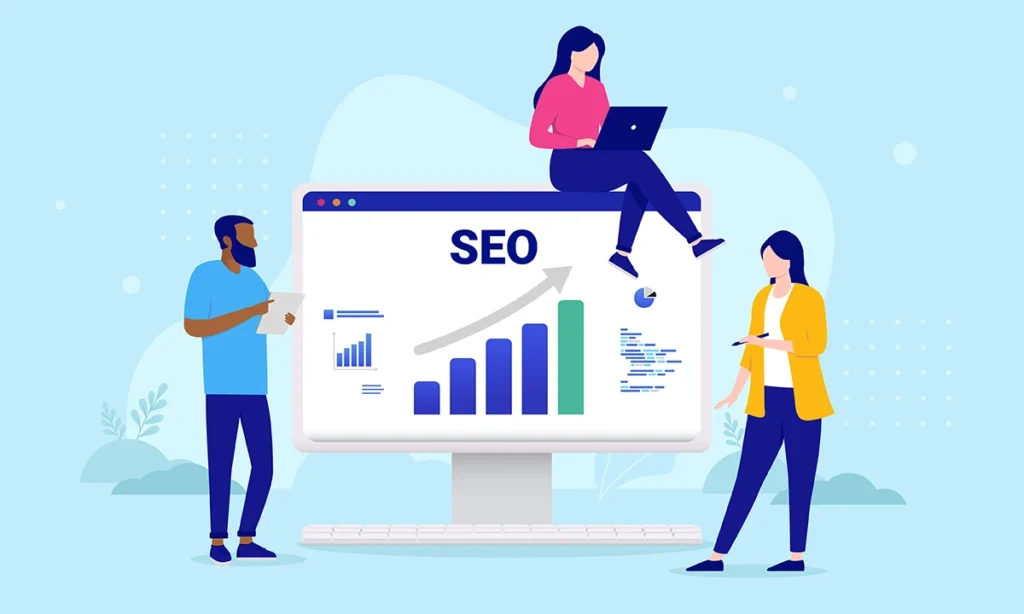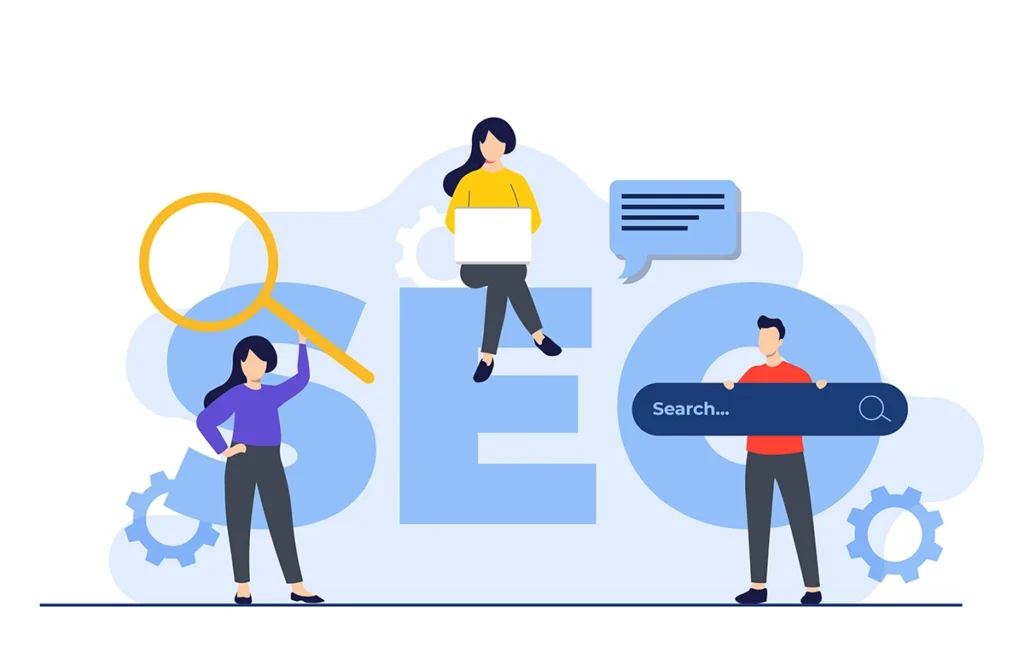Did you know that there are over 1.1 billion websites on the internet?1 For businesses today, being visible online isn’t optional; it’s essential to growth and success. However, simply having a website isn’t enough. Ranking well in search results requires a strong digital marketing strategy and ongoing Search Engine Optimization (SEO).
In this guide, we explain everything there is to know about SEO, including what it is, how it works, and why it’s so vital for any business that wants to succeed online.
Table of Contents:
What is Search Engine Optimization (SEO)?

So, what is SEO exactly? In simple terms, search engine optimization is a digital marketing strategy that focuses on boosting a website’s visibility in search results. When you search for something online, the websites you see first are the ones with SEO strategies that align best with search engine algorithms.
Heather Chloe Wallace has been the SEO department lead at West County Net since 2021. When asked how she would explain search engine optimization to someone completely new to it, she said:
“SEO helps search engines like Google understand what your website is all about which in turn helps users find it online. The concept is simple, but executing it effectively requires balancing the needs of both search algorithms (machines) and searchers (people).”
At its core, an effective SEO strategy will ensure your website ranks higher when someone searches for information, products, or services related to your industry.
To achieve this, every successful search engine optimization strategy will consist of three key components: on-page SEO, off-page SEO, and technical SEO.
On-Page SEO
On-page SEO is all about optimizing the content and structure of your website. This means making sure your website is well-organized and easy to understand, both for people and search engines.
Key aspects of on-page SEO include:
- Keyword Optimization: Strategically using keywords throughout your website to help search engines understand what your site is all about and show it to people making relevant searches.
- High-Quality Content: Creating valuable and informative content that people want to read, share, and engage with.
- Tag Optimization: Using descriptive code elements like title tags, meta description, image alt-tags, etc., to help both people and search engines understand the content of each individual webpage.
Off-Page SEO
Off-page SEO focuses on external optimization practices that build your website’s reputation and authority. This is done by establishing connections, typically meaning links, from other websites to yours. In SEO, these links are called backlinks.
Every time another reputable website links to your website, it signals to Google and other search engines that your site is valuable and trustworthy. While high-quality backlinks can improve your site’s search ranking and visibility, low-quality or broken backlinks can have a negative impact.
Key off-page SEO strategies include:
- Backlink Auditing: Understanding where backlinks come from is essential for assessing how a website is shared online and its overall visibility. Since content and links frequently change, regular auditing can identify outdated or broken links, allowing for necessary corrections to maintain a strong online presence.
- Listing Management: Creating and managing online listings that feature your business name, address, and phone number. These listings may include location-based platforms like Google Maps, Apple Maps, and MapQuest, as well as community directories such as Yelp and Facebook. Industry-specific directories, like the Better Business Bureau (BBB) and Yellow Pages, also play a role in improving visibility and credibility.
- Social Signals: When a business shares useful and engaging content on social media, it generates signals that can enhance online visibility, including in search results. Likes, shares, and other user interactions with this content strengthen these signals, further increasing a business’s online visibility.
Technical SEO
Technical SEO ensures your website is technically sound. This behind-the-scenes work keeps your website easy for people to use and for search engines to understand.
Important aspects of technical SEO include:
- Website Speed: Ensuring your website loads quickly.
- Overall Site Hygiene: Addressing issues like broken links, missing image alt-text, thin content, orphaned pages (pages not linked from anywhere), and more.
- Mobile-Friendliness: Making sure your website looks good and works well on mobile devices.
- Sitemap: A file that lists all URLs on your website and helps search engines understand, crawl, and index web pages.
- Structured Data: Implementing structured data, or schema markup to help search engines understand the content on your website better.
Types of SEO Strategies

There are many different types of search engine optimization strategies, each designed to achieve specific goals based on the kind of business you have. While the ultimate objective of any SEO strategy is the same—to improve search engine rankings—different types of businesses require different optimization tactics to achieve this.
Local SEO
Local SEO focuses on optimizing your website so people in your area can find you when they search for info, services, or products related to your industry. For example, if someone searches for “coffee shop near me,” Local SEO ensures your business shows up in the results.
This strategy is ideal for a business with a physical location like shopping boutiques, restaurants, beauty salons, etc.
Heather is our Local SEO expert at WCN. She loves getting to know the heart of a business and what makes their brand unique so they can stand out in a crowded digital landscape:
“My personal favorite type of SEO is local SEO. Our community thrives on local businesses, and they are usually the last ones to bite the bullet and buy into SEO. But it really is so important nowadays to have a strong online presence. And that’s especially true for smaller businesses because they are competing in an increasingly globalized market.”
Ecommerce SEO
Ecommerce SEO is designed for businesses with online stores that sell products directly through their websites. The ultimate goal is to make your online store visible to customers searching for what you sell, increasing both traffic and sales.
For example, if someone searches for “waterproof rain jacket,” Ecommerce SEO helps your store’s product pages appear in the search results.
Franchise SEO
Franchise SEO is for businesses with multiple locations, such as chains of retail stores, restaurants, or gyms. It ensures that each location ranks well for searches in its specific area.
For instance, if someone searches for “gym near me”, Franchise SEO makes sure the location closest to them appears in the results.
How Does SEO Work?

SEO works by aligning a website’s content, structure, and technical elements with search engine algorithms. These algorithms are essentially complex formulas and machine learning models that search engines like Google use to crawl, index, and rank websites:
- Crawling: Search engines send out “spiders” or “bots” to explore the internet and gather information about websites.
- Indexing: The info is then organized into a giant database (called an index) so it’s easy for the search engine to find when a user needs it.
- Ranking: When someone searches for something, the algorithm analyzes the query and shows them the most relevant websites from its index.
Once a webpage is crawled and indexed, search engine algorithms evaluate various factors to determine where it ranks in search.
How Search Engines Rank Websites
The goal of any search engine is to provide users with the most relevant and useful information. To do this, search engine algorithms evaluate hundreds of factors to determine how useful and relevant a website is to a particular search query.
Key factors influencing website ranking include:
- Relevance: Search engines analyze things like keyword relevance and topic depth to determine if a webpage matches a user’s query and search intent.
- Content Quality: Search algorithms prioritize high-quality content that is easy to understand, informative, and original.
- E-E-A-T: Content that shows practical experience, subject matter expertise, authority in the field, and trustworthiness (EEAT) tends to rank better in search.
- User Experience (UX): Websites that are easy to navigate, have fast loading times, and are mobile-friendly are more likely to rank higher.
- Structured Data: Webpages with structured data like scheme markup help search engines better understand the content, boosting visibility in relevant searches.
Even though specific ranking factors are a closely guarded secret, in Heather’s experience, search engines continually reward websites that prioritize user experience and high-quality content:
“I tend to agree with what Google themselves say: content that ranks is content that pleases users. It answers their questions in a way that’s easy to understand, and users enjoy the experience. Of course, it also helps to make your website easy for search engine crawlers to understand so they can serve it to the right users for relevant queries.”
Search engine algorithms are constantly evolving through updates designed to deliver more accurate and relevant results to users. So while there will never be a fool-proof recipe for ranking #1 in search, one thing you should always strive for is quality.
By creating valuable, high-quality content that answers questions, solves problems, and engages your audience, you can position your business for long-term SEO success.
Why is SEO Important for Businesses in 2025?

Today, the phrase “Google it,” is pretty much universally used and understood. Just about everyone uses the internet to find everything from information and answers to products and services, and everything in between.
But with nearly 252,000 new websites popping up every day1, succeeding online is no easy task. For businesses to truly flourish in the digital age, a strong SEO strategy is essential. Read on to learn why.
Rank Higher in Search Results
Search engine optimization helps your business appear at the top of search results, making it easier for potential customers to find you. With less than 1% of users looking at the second page of Google results2, ranking well in search is incredibly vital for businesses.
Plus, high search engine rankings also establish credibility and trust with potential customers, leading to increased brand awareness and customer loyalty.
Mobile Search Optimization
By improving factors like page load speed, navigation, and overall user experience, SEO ensures your website is fully mobile-friendly. This ultimately leads to increased visibility for mobile users.
Considering over 60% of Google searches are performed on mobile devices3, and over 70% of shoppers use their mobile phones to buy online4—this should be a major priority for all businesses.
Maintain a Competitive Advantage
Over 69% of businesses actively invest in SEO.5 So if you’re not investing in SEO, your competitors likely are. As Heather highlights, failing to optimize your website essentially gives your competitors a direct advantage over you:
“Without SEO, your website is effectively invisible online. And because SEO is a zero-sum game, your loss is your competitor’s gain.”
Almost 6 million Google searches are conducted every minute.6 That means your potential customers are likely searching for your products or services literally right now. Are they finding you or your competition?
24/7 High-Quality Lead Generation
Optimizing your website doesn’t just drive more traffic, it drives the right traffic. SEO helps put your website in front of the people who are actively searching for what you offer.
This means your site becomes a powerful tool for attracting high-quality leads and growing your business 24 hours a day, 7 days a week, 365 days a year.
The Future of SEO in 2025

Search engine optimization is an ongoing process that requires continuous effort and adaptation. You can’t optimize a website once and just expect it to maintain high rankings indefinitely.
Search engine algorithms are constantly changing, updating, and evolving. The way people use search engines is also constantly changing. As Heather explains:
“While the overall goal remains the same—pleasing users—search engines like Google are constantly refining how they do that. You have to remember that a search engine and its crawlers are machines, and they can only think and act as far as their programming allows. But search engine users are humans, and the way we think is still a bit of a mystery. So trying to make a search algorithm behave the same way as a human brain takes a lot of code writing, editing, tweaking, and amending.”
SEO is a dynamic and ever-evolving process that requires ongoing work and modifications. To stay ahead, optimization strategies have to adapt to algorithm updates, changes in user search behavior, and emerging technologies.
Some of us remember a time when people had to ask a cartoon butler named “Jeeves” to search the Web for answers to their questions… But today, artificial intelligence (AI) is at the core of how search engines operate.
Artificial Intelligence (AI) and Search Engines
The introduction of Google AI Search Experience and Bing Generative Search in 2024, dramatically transformed the SEO landscape. These AI-driven search experiences have revolutionized how content is evaluated, ranked, and presented, as well as how users interact with search engines.
Some key SEO best practices to optimize for AI-driven search engines:
Consider User Search Intent
Search intent refers to the purpose or goal behind a user’s search query, like what they are hoping to accomplish or find when they type something into a search engine.
With AI technologies, like natural language processing (NLP) and advanced machine learning algorithms, search engines can interpret context and user search intent more effectively than ever. In other words, search engines don’t just match keywords to search queries, they can assess the broader meaning and relevance behind a search, allowing for more accurate and useful results.
This means to ensure visibility in AI-powered search results, creating web content that addresses the specific needs, questions, and pain points of your target audience is vital.
Provide Comprehensive Information
AI search algorithms prioritize content that goes beyond surface-level information and presents a full, nuanced understanding of a topic. When your website provides clear, structured, and valuable information, users are more likely to stay on the page longer, engage with it, and return for more.
These factors not only signal to search engines that your content is high-quality but also establishes you as a trustworthy expert with your audience.
Use Structured Data
In the era of AI, implementing structured data has become even more crucial for SEO success. Structured data, like Schema Markup, helps AI search algorithms better understand the meaning and context of a web page.
This is particularly important for ensuring search engines interpret your content accurately and align it with user search intent.
Structured data also enhances your chances of appearing in search features like rich snippets, knowledge panels, and AI-generated overviews, boosting visibility and driving more traffic to your site.
Expand Your Reach
AI-generated overviews often provide answers directly in search results, reducing the need for users to click through to websites. In the SEO industry, this is referred to as zero-click searches.
To combat this, businesses should focus not only on creating high-quality, engaging content, but also distributing it across multiple channels. Sharing content on social media, in newsletters, and within online communities helps reach audiences where they are.
This ensures your content keeps working for you—driving website traffic, building brand visibility, and sparking engagement beyond search alone.
The Bottom Line
As search engines continue to evolve, one thing still remains clear: user satisfaction is at the heart of SEO. AI, while transformative, is ultimately a tool to better serve people.
Businesses that focus on creating and sharing high-quality, engaging, and accessible content will be best positioned to succeed online. Search algorithms will always keep changing, but when you prioritize users, you build a foundation for long-term SEO success.
Get a Free SEO Audit to Learn How SEO Can Benefit Your Business

Search engine optimization is more than just a digital marketing buzzword—it’s a critical strategy for businesses of all sizes. Investing in SEO means investing in long-term growth. By improving your website’s visibility on search engines, SEO ensures that your target audience can find you when they search for what you offer.
Ready to take your business to the next level? Don’t wait—the sooner you optimize your website, the sooner you’ll start seeing results. Use the form below to contact West County Net for a free SEO audit and discover how our strategies can help you achieve your goals.
"*" indicates required fields
References
- Matt, & Matt. (2024, November 11). How many websites are there? Digital Silk. https://www.digitalsilk.com/digital-trends/how-many-websites-are-there/
- Beus, J. (2021, January 19). Click probabilities in the Google SERPs – SISTRIX. SISTRIX. https://www.sistrix.com/blog/click-probabilities-in-the-google-serps/
- Pangarkar, T. (2025, January 13). Google Search Statistics 2025 by Algorithm, Results, growth. Market.us Scoop. https://scoop.market.us/google-search-statistics/
- Team, S. (2023, August 10). Top 106 SEO Statistics. Semrush Blog. https://www.semrush.com/blog/seo-statistics/
- Elad, B. (2023, August 21). SEO statistics by organic search traffic, ranking, Industry/Company, business, mobile, platform, country, activity and satisfaction rate. Enterprise Apps Today. https://www.enterpriseappstoday.com/stats/seo-statistics.html
- Jones, P., Skopec, C., & Lahey, C. (2024, January 11). 34 Eye-Opening Google Search statistics for 2024. Semrush Blog. https://www.semrush.com/blog/google-search-statistics/
